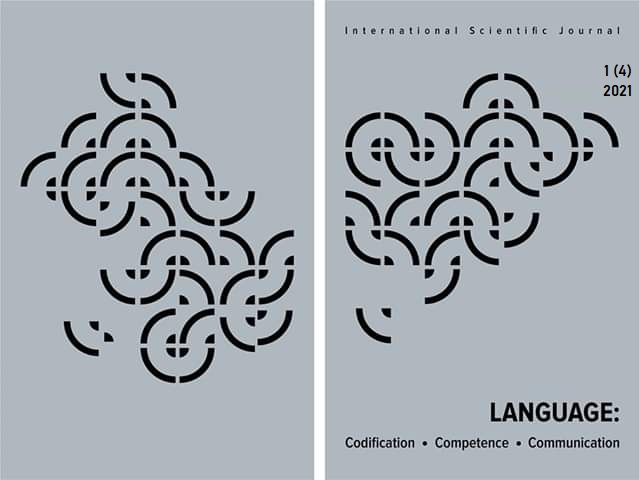PROPOSALS ON IMPLEMENTATION OF THE CONCEPTION OF MIXED PARTS OF SPEECH IN UKRAINIAN LINGUISTICS
DOI:
https://doi.org/10.24025/2707-0573.1(4).2021.231684Abstract
Background. The actuality of the proposed article is related to the need to overcome fundamental differences between conclusions of the academic linguistic works and recommendations of manuals on the Ukrainian speech culture, on the one hand, and what learning materials are taught in Ukrainian universities, on the other hand. These differences are related to the peculiarities of the Ukrainian language means of expressing process concepts, which are different from means of neighboring Slavic languages.
These differences are caused by the fact that the Ukrainian linguistics lacks the unequivocal, consistent and generally accepted conception of the verb as part of speech and of the part-of-speech affiliation of verbal formations, of the systems of their grammatical features and associated understanding of their semantics and the rules of usage in various syntactic structures.
Іn the light of this, it is necessary:
– to compare two dominating approaches to the definition of the verb as part of speech: 1) conventional approach, realized in Soviet and post-Soviet grammars; 2) new semantic-grammatical approach, proposed by I.K. Kucherenko and elaborated by I.R. Vykhovanets;
– to propose how to further determine the verb and the derived verbal formations.
Purpose: to propose ways of eliminating some of contradictory provisions of the new semantic-grammatical approach and ways of supplementing it with the conception of mixed part of speech.
Methods. The main method refers analyses of the works on grammar and terminology science.
Results. The two dominating approaches to the definition of the verb as part of speech are compared, and significant advantages and certain contradictions of the second approach are highlighted.
In particular, analyses is done on semantics, grammatical features and common usage peculiarities of verbal forms in ‑no, ‑to, infinitive, diiepryslivnyk, deverbal noun in ‑nnia, ‑ttia with process meaning (hereinafter referred to as "verbal noun") and diieprykmetnyk. It is confirmed that verb forms in ‑no, ‑to and infinitive are affiliated to the verb as a part of speech, whereas the diiepryslivnyk, verbal noun and diieprykmetnyk are not forms of the verb, but the lexical-grammatical ranks of deverbal adverb, noun and adjective respectively.
It is shown that inheriting the grammatical meaning of vyd category and the certain valence position from derivative verb relate diiepryslivnyk, verbal noun and diieprykmetnyk with the verb not only word-formatively and semantically, but also grammatically. Due to this grammatical relationship, they differ significantly from the proper deverbal adverbs, nouns and adjectives of the same root that have completely lost all verbal grammatical categories and therefore they represent the result of complete semantic transition from the verb to adverb, noun and adjective respectively.
Discussion. Just the grammatical relationship of diiepryslivnyk, verbal noun and diieprykmetnyk with the verb gives the reasons to consider these formations as mixed parts of speech.
It is proposed to review the structure of the Ukrainian grammar course and to implement a special section "Mixed parts of speech" in order to clearly reflect the grammatical, semantic and word-usage distinctions in these formations from proper deverbal adjectives, adverbs and nouns.
Keywords: ‘vyd’ (aspect), valency, personal forms of the verb, ‘diieprykmetnyk’ (participle), ‘diiepryslivnyk’ (adverbial participle), verbal form in -no, -tо, verbal noun (deverbal noun in ‑nnia, ‑ttia), infinitive, process
Downloads
Published
Issue
Section
License
Copyright (c) 2021 Михайло Давидович Гінзбург

This work is licensed under a Creative Commons Attribution-NonCommercial 4.0 International License.
Authors hold full copyright and at the same time they transfer the publishing rights to the journal. The author of a published article has the right to distribute it, post the work in the electronic repository of his/her institution, publish as a part of a monograph, etc. with a required link to the place (output) of its first publication.
The authors confirm that the scientific article submitted for publication has not previously been published and has not been submitted to the editorial office of other journals.
If you have any questions, please contact us:
email: ukrmova@chdtu.edu.ua, o.pchelintseva@chdtu.edu.ua
Viber / WhatsApp: +38 093 789 09 27


